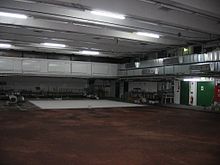Stage painter

Stage painters and stage sculptors (in the past they were also decorative painters ; Switzerland: theater painters ) are skilled workers primarily in the theater and film , but partly also in trade fairs , events and exhibitions , who are responsible for the production of backdrops and comparable decorations.
Job description and training
Up to the 19th century, stage sets consisted mainly of painted rear prospects , which the decorative painters were responsible for making. The need in the larger cities was immense. A considerable part of the painters made their living with such decorations. Today the profession is more specialized and primarily responsible for the artistic and technical implementation of the stage designer's designs . Depending on the type of institution and the distribution of tasks, the stage painters and sculptors are also involved in advising directors , set designers or designers , in selecting and ordering colors and materials, and in cost planning.
Stage painter / stage sculptor is a recognized occupation in Germany since 2000. In Austria, stage painter is a specialization in the teaching profession of painter and house painter or training in the field of artistic design , for example at a technical school for painting and design or a higher educational institution for artistic design.
A certain artistic talent, color sense and spatial imagination, but also the ability to adapt to different artistic styles is necessary. Transporting the stage parts is primarily the job of the stage workers , but physical ability and no problems when standing for long periods are a prerequisite.
Stage painter
With stage painting , the focus is on color and two-dimensional, with stage sculptor on spatial, three-dimensional design. Stage painters implement the design by applying surface structures and / or painting backdrops or decorations .
Stage sculptor
Stage sculptors model backdrops, spatially reproduce objects or living beings and imitate surface effects.
These can be parts of house facades , landscapes or statues of people or animals. He also makes movable elements or costume sculptures and ornaments as well as casts of faces or limbs. It is important that the sculptor is familiar with the possible processing methods of the most varied of materials that are suitable for the special task and knows how to produce a stable and safe element of the stage.
Field of activity
In addition to the materials available in specialist shops for theater supplies ( pigments , structure pastes, ready-to-use paints, adhesives and the like, generally cheap, large quantities and not made to last), all materials are used in theaters , as the stage sets often demand realism (all types of Building materials, textiles, paints). It is essential, and possibly a point of conflict with the set designer, that they are as light as possible, elastic and shock-resistant enough to withstand the transport of the sets, which are mostly made of wood, and that they meet the respective fire protection requirements, depending on their use in the stage area, if necessary, are flame retardant ( fire protection class B1) or impregnable in a flame retardant manner, or may not be combustible.
Painting in the true sense of the word (a copy of any template or free design according to the stage designer) is often made on the stage brochures , for example from cotton nettle. The colors for this as well as for the painting of the other backdrops are mostly water-thinnable, little solvent-based colors, especially poster paint , emulsion paints and acrylic paints , because of the very large surfaces . Nevertheless, a lot of different fabrics are used again and again, especially by stage sculptors, which is why increased attention to occupational safety is required.
The brochures and backdrops are usually stapled (under tension) on the floor during processing, the tools are mainly to be used with one or two hands on handles (brush: "brushes" up to 35 cm long on a 2 m long handle , "Landscapes" up to approx. 10 cm wide on an 80 cm long handle), so that you can work upright. For stencil work or surface treatment, you still have to crouch down for the most part.
Web links
- Germany:
- Switzerland:
